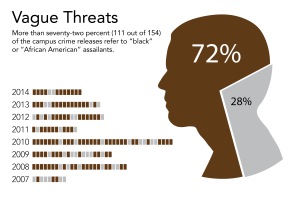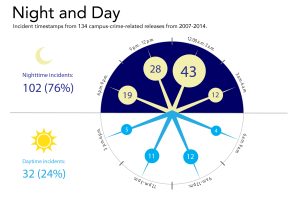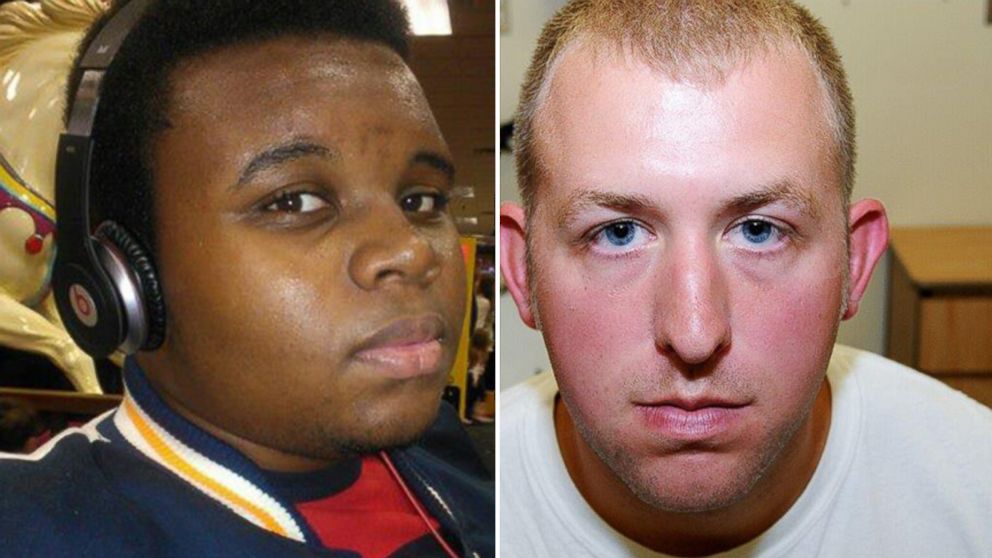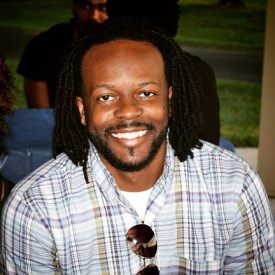Eight Years a “Wooden Opponent”: Genre Change (and its Lack) in Campus Timely Warnings
Timely Warning: 14-11, July 21, 2014
Reported Crime: Armed Robbery– Off Campus
The Police are investigating a report of an armed robbery that occurred at approximately 1:30 a.m. Monday, July 21, at 950 Railroad St (north of…campus).
The victim, a female student, reported that she was in her apartment when she was approached by three houseguests. Two of the suspects produced handguns and demanded her belongings. The suspects fled the area in a vehicle.
Suspect One: Black male, approximately five feet four inches tall, dark skinned, with a “high fade” haircut.
Suspect Two: Black male, light skinned, curly afro, wearing a black shirt, and armed with a silver revolver.
Suspect Three: Black male, dark skinned, armed with an unknown handgun.
(excerpt from Timely Warning 14-11; identifying references removed).
At our university, an average of twenty Timely Warnings such as the one above are distributed in email inboxes each year. In accordance with the Clery Act, a US law that mandates such alerts, these campus-wide notifications describe alleged criminal activity that takes place on or near campus. Timely Warnings are so well-codified that, at first, they seem algorithmically produced, as though their presence in our inboxes indicates a simple truth about campus safety and the assailants who would do us harm. However, taking a Critical Discourse Analytic approach to this archive demonstrates that over its eight-year lifespan, some conventions of the Timely Warning genre have been incredibly dynamic—for instance, titles, form, and structure. Such dynamic genre change makes the constant elements all the more notable. One particularly constant variable across this archive is the vaguely attributed assailant: an African-American male in his 20s between 5’2 and 6’3”. This ambiguous descriptor renders nearly a quarter of the campus community a threat: discursively criminalizing students, faculty, and staff of color.
Genre studies scholarship has done well to establish that writing genres are situated and that they “change, evolve, and decay” (Miller 163; see also Devitt, Dirk). Since genres are situated in this way, analysis of genre change provides insight into the attendant social context. In this article, we trace the life of the Timely Warning genre, examining the discrepancy between what the Timely Warning genre was designed to do—bring the university in compliance with the Clery Act—with what it has adapted to try to do, make the campus community “responsible for [their] own safety” (“Annual Safety Report (2011)”). This disconnect creates a discursive problem with real consequences for campus race relations and the safety of those students, faculty, and staff who match the descriptors of the Timely Warnings. Because the Timely Warning genre positions the university community as a “wooden opponent”—genre theorist Anne Freadman’s gloss for potential agents that cannot or will not respond—it cannot succeed in its goal of developing relationships to maintain safety; instead, the playing out of this particular language game creates a discursive product that undercuts campus safety and creates a climate of fear and anxiety.
Timely Warnings as Genre
In her landmark essay, “Anyone for Tennis?” (2003), Freadman extends the analogy of tennis to theorize the ways genre is situated in time and place. Referring specifically to menus, how-to manuals, and classroom dynamics involving exchanges between teachers and students, she describes how genres function effectively in social interaction. To illustrate the undesirable alternative—one in which a text is monistic, delivered unidirectionally with its meaning reduced to a set of formal features—Freadman sets up as an analogy her experience of practicing tennis by hitting balls against a wall, a “wooden opponent” that does not recreate the game of tennis, nor does it participate in any meaningful way; it just allows the ball to return (43). All in all, this amounts to an ineffectual exercise that does not take into account an audience nor expect an authentic response.
We draw on Freadman’s generative metaphor to understand the implications of the genre Timely Warnings, a crime-reporting system that was initially instituted at our university in 2007 in the wake of a university scandal, which stemmed from the cover-up of a student’s rape and murder. In addition to a national outcry over the crime and subsequent misdeeds, the incident brought the university in direct violation of the Clery Act (1990), which requires colleges and universities to keep and disclose information about crime on and near their campuses. The Clery Act stands as a federal mandate that obligates colleges and universities to compile and publicize crime statistics, circulate an annual crime report, devise plans for emergency responses, and circulate timely warnings in an effort to safeguard students and employees (Clery Center for Security on Campus). Nearly as soon as it was created on our campus, the genre was asked to adapt to a new exigency: the effort to increase campus safety by explicitly sharing some of the responsibilities of policing campus with students, faculty, and staff. Robert Heighes, the university Chief of Police, describes such efforts as follows: “Your safety is our concern. It also must be your concern. […] [We] work hard to prevent crime, fire, accidents and illness, but nothing is as important as what you do and, in some cases, don’t do” (“Annual Safety Report (2011)” iv, emphasis added). Thus, in its updated incarnation the genre functions to remind the university community that they are not only complicit in their safety but also responsible for potential breaches in safety. We argue that it is this new exigency that overburdens the genre, creating a discursive product that runs counter to the stated aim of working together as a campus community to keep everyone safe.
Critical Discourse Analysis of Timely Warnings
Our initial analysis focused on 189 messages about crime and related activity on and in the immediate vicinity of campus from September 10, 2007, the online archive’s earliest record, to September 6, 2014. The 189 messages include documents titled as Timely Warnings (77), Informational Releases (57), Updates (26), Notices (including Safety Notices and Security Notices) (26), and Additional Information (1). Fluctuations in document naming were especially pronounced in the first half of the eight-year sample; in the most recent three years, however, all releases were posted as Timely Warnings, Updates, and Notices. Naming modifications indicate an initial quality of adaptiveness; the Timely Warning genre appears to change over the eight years sampled, though its changes accord with its principal function as an instrument of Clery Act compliance.
Across the sample, the briefest release was just 16 words, while the longest was an anomalous 1,455 words—nearly three times longer than the next longest release at 500 words. Such a long release provides a clearer narrative account of the crime, though this is the rare exception in the collection. The average word count is 198, which fits within a relatively constant scope in that releases typically include some identification of a crime or suspicious activity, location information, a timestamp, an account of what happened, a description of assailants (when available), and, especially in the more recent half of the sample, a bulleted list of standard warnings and reminders about being watchful.
To make sense of this rich dataset, we used Critical Discourse Analysis in the tradition of Language in Social Interaction. We created inductive codes based on careful reading of the archive and discussion among all three study participants. Increasingly recognized as an effective methodology within Rhetoric and Composition (Huckin and Clary-Lemon, Lewis, Powell, Price), and particularly for genre study, Critical Discourse Analysis has been described as “discourse analysis with a critical thrust” (Tracy, Inez-Guillam, Robles, and C’Astenline 246). As a theory/methodology that closely examines discourse and its relationship to social interaction, the primary purpose of Critical Discourse Analysis is to reveal implicit, yet unjust discursive relationships to provide an opportunity for social change.
Change and Constancy Across an Adaptive Genre
Analysis of the archive brought to the surface both complex, gradual adaptations as well as patterns of constancy—both of which in different ways reinforce functional limitations of Timely Warnings that prohibit them from becoming anything more than an instrument of Clery Act compliance. In this section, we describe our dataset, and, in particular, three rich features that stood out in our analysis. We examine first the highly recurrent references to vaguely identified “African American” and “black” assailants, which, because it is a consistent feature, serially correlates criminality with a large segment of the campus population. Second, we note the slow emergence of lists of bulleted safety tips, which frame releases as inviting genuine, participatory uptake from its recipients. Finally, we address the non-“timely” nature of the genre through close attention to the archive’s timestamps.

As demonstrated in Figure 1, in the 154 Timely Warnings where a suspect identifier is provided, an “African American” or “Black” male is mentioned 111 times (72%). Further, Figure 1 illustrates how, by asking the campus community to use the Timely Warnings to keep safe by looking for potential threats, the face of crime on campus is cast as overwhelmingly African American. Beyond the consistent presence of African American assailants, the Timely Warnings do not provide subject details that might make the descriptions meaningful. This places the identifying characteristics of assailants on an extremely broad spectrum. Some of the identifiers that were prevalent in our sample describe assailants as “Black male, heavy set, 20-30 years old, clean cut,” and “African American males, late twenties to early thirties, and wearing dark clothing.” Vague characteristics like these foster an uncomfortable climate where every African American male on campus fits the description for criminal activity.
At its inception, Timely Warning releases only provided blurb-like information about criminal activity with little or no guidance about how to be an active participant in ensuring one’s safety. In March 2008, however, a modest form of stock safety tips began to be included in the notices. Notably, the earliest appearances of tips were irregular, varying in length and scope. By 2010, every Timely Warning included an expanded bulleted list that urged vigilance and self-responsibility. The tips asked students to “Be aware of your surroundings and look assertive,” “Walk with friends or coworkers when possible,” “Contact SEEUS for nighttime escorts,” “Trust your intuition, if a particular situation makes you feel uncomfortable, choose an alternative,” “If you feel threatened on campus, look for a blue light phone to call for assistance,” “Program the number for Police into your cell phone,” and check the university website for additional public safety tips (Irwin).
This generic change—the serialized list of tips, stabilized over time—contributes to the seemingly algorithmic rhetoric perpetuated by the releases and is illustrative of a thickening effort by the university to promote a culture of diligence and awareness among campus constituents. In fact, the 2012 Annual Safety Report explicitly acknowledges a causal linkage between the safety tips and personal safety, connecting the two as follows: “Please pay special attention to the safety tips. Following them will reduce the chances that you’ll be the victim of crime, become injured or lose valuables” (“Annual Safety Report (2012)” 1).
This increasingly urgent call for campus vigilance is particularly troubling given the sense of time promoted by the timely warnings. In our analysis, timestamps appear in 134 of the releases, and these indicate that 102 (76%) of the reported acts occurred between 6 p.m. and 6 a.m. (Figure 2). This is significant because, although the acts reported take place primarily in the overnight hours, their releases circulate predominantly during daytime hours. Considered in light of the University’s hours of operation and the conventional work schedules of a majority of campus stakeholders, this alternating time is to be expected. And yet it calls into question the reference to “timely” in the Timely Warnings. That is, because the acts and their campus safety releases sustain across a kind of double-time, they communicate an ominous, persistent threat that, as Figure 2 demonstrates, lingers, always-on, around the campus landscape. The untimely circulation of safety messages encourages the campus community to look for potential criminals at all times.

These features—the repeated reference to vague assailants who walk known and yet unknowable among us, the quasi-participatory list of safety tips, and the message that danger is always imminent, regardless of the time of day—suggest a recirculating message that lacks meaningful, genuinely participatory engagement. With each issuance of a new warning, faculty, staff, and students stand in as inanimate recipients, resembling the wooden opponent Freadman describes in her tennis analogy. In fact, nothing about these notices elicits any type of volley or genuine opening for response from the university community. As such, communication about crime and safety becomes a purely one-way broadcast circulated by the university out to its constituents, certainly appropriate for crime alerts but not as an invitation to collaboratively maintain campus safety.
Implications and Conclusions
Nationally, the broad, decentralized fear of black men has risen to a fever pitch. Thus, under the guise of community safety, public discourses circulate attempting to frame as justifiable the killings of Freddie Gray in Baltimore, MD; LaQuan McDonald in Chicago, IL; Walter Scott in Charleston, SC; Trayvon Martin in Sanford, FL; Michael Brown in Ferguson, MO; Tamir Rice in Cleveland, OH; and Eric Garner in New York. Our concern then is that Timely Warnings, as campus-sponsored communication that identifies African American faces as potentially threatening, undercut the strategic goals of the university and develop a climate of anxiety that provides the foundation for unfounded, preemptive violence against black men. Our analysis of this archive identifies the disparity between the initial purpose of Timely Warnings, compliance, and its subsequent purpose, to promote safety on campus by making the campus community stand their own ground. Unfortunately, the genre is beholden to its constraints of compliance. The attempt to adapt its purpose to allegedly promote a dialogic relationship regarding safety demonstrates the underlying problem of the genre: it was not built to do that which it has subsequently been asked.
Unfortunately, there are few counter-narratives on campus to challenge or disrupt the resulting anxiety that Timely Warnings produce. One potential intervention is offered by African American students who wear t-shirts declaring, “I am a Timely Warning.” Since the vast majority of Timely Warnings identify African American suspects in their early 20s, with a height resting within the spectrum of 5’2 to 6’3, and a skin tone on a subjective continuum between “light-skinned” to “dark-skinned,” virtually every African American male on campus is (a) suspect. Some openly joke about their apprehension of wearing dark clothing because it aligns them too closely with a “timely” description. Since Timely Warnings are broadcast without an authentic mechanism for discussion or exchange, the university community, as wooden opponents, has no agentive opportunity for participation, and the genre does not provide a space for resistance. Campus constituents must merely stand vigilant, albeit woodenly so. However, eliciting unchecked and unexamined vigilance, fear, and anxiety does not keep us safe.
All universities face the challenge of balancing public safety, public relations, and student support, as does our institution. The fact that the Rave system, which offers immediate campus alerts, has 1,000 clients in higher education, speaks to the widespread nature of this challenge (Misner). And with this institutional critique we do not mean to suggest that the university should curtail communication about crime. Rather, we identify a problematic relationship between the legal purpose of the Timely Warnings, their purported role in maintaining a safe campus, and their actual discursive production. To address this, we recommend the following: 1) Timely Warnings should only provide compliance with the Clery Act; they should not try to do more than this. It is important that universities comply with this law, and our institution knows firsthand the implications of ignoring this responsibility. Transparency about such information is central to university ethos and community trust. 2) The university must create a participatory structure that allows all university stakeholders a role in shaping a safe and respectful community and that combats narratives that equate African American men with criminality.
Promoting safety on campus is increasingly complex, and it requires an institutionally-sponsored genre that allows for broad participation and responsiveness. Reporting crime and creating a safe campus are two important goals for all universities, but, unfortunately, the Timely Warnings demonstrate that these needs cannot be met in the same genre. Further, Critical Discourse Analysis of this archive reveals how through the Timely Warning system the university is, perhaps unwittingly, complicit as a sponsor of discourse that constructs African American men as criminal. Without a university-sponsored counter-narrative, the Timely Warnings sanction a problematic, unidirectional approach to maintaining safety, which has tangible consequences that reverberate farther than our respective campuses.
Works Cited
- Binks, Daisy. Moon. The Noun Project, 2013. Web. 15 Nov. 2014.
- Clery Center for Security on Campus. Summary of the Jeanne Clery Act (2012). Web. 24 June 2015.
- Department of Public Safety. Annual Safety Report (2012). Eastern Michigan University, 2012. Web. 15 Dec. 2014.
- Department of Public Safety. Annual Safety Report (2011): Eastern Michigan University, 2011. Web. 15 Dec. 2014.
- Devitt, Amy J. Writing Genres. Carbondale: Southern Illinois UP, 2004. Print.
- Dirk, Kerry. “Navigating Genres.” Writing Spaces, Vol. 1. Eds. Charles Lowe and Pavel Zemliansky. Clemson, SC: Parlor P, 2010. 249-262. Web.
- Eastern Michigan University. “Timely Warning: 14-11, July 21, 2014.” Timely Warning & Safety Notices. 21 July 2014. Web. 12 Sept. 2014.
- Fougere, Dominique. Man. The Noun Project, 2013. Web. 15 Nov. 2014.
- Freadman, Anne. “Anyone For Tennis?” Genre in the New Rhetoric. Bristol, PA: Taylor & Francis, 2003. 43-66. Print.
- Huckin, Tom, Jennifer Andrus, and Jennifer Clary-Lemon. “Critical Discourse Analysis and Rhetoric and Composition.” College Composition and Communication 64.1 (2012): 107-129. Print.
- Irwin, Mary Beth. “2010 Safety Tips.” Message to Derek Mueller. 28 July 2015. E-mail.
- Lewis, Cynthia. “‘What’s Discourse Got to Do With it?’: A Meditation on Critical Discourse Analysis in Literacy Research.” Research in the Teaching of English 40.3 (2006): 373-379. Print.
- Miller, Carolyn R. “Genre as Social Action.” Quarterly Journal of Speech 70 (1984): 151-167. Print.
- Misner, Jared. “Too Many Campus Alerts?” The Chronicle of Higher Education. 19 Sept. 2014. Web. 4 Dec. 2014.
- Powell, Pegeen Reichert. “Critical Discourse Analysis and Composition Studies: A Study of Presidential Discourse and Campus Discord.” College Composition and Communication 55.3 (2004): 439-469. Print.
- Price, Margaret. “Access Imagined: The Construction of Disability in Conference Policy Documents.” Disability Studies Quarterly 29.1 (2009). n. pag. Web. 4 Dec. 2014.
- Raphael, Jory. Sun. The Noun Project, 2012. Web. 15 Nov. 2014.
- Tracy, Karen, Susana Martinez-Guillem, Jessica S. Robles, and Kimberly E. C’asteline. “Critical Discourse Analysis and (U.S.) Communication Scholarship Recovering Old Connections, Envisioning New Ones.” Communication Yearbook 35 (2011): 241-274. Print.
Cover Image Citation:




 Kate Pantelides is an assistant professor in the department of English at Middle Tennessee State University. She teaches courses in rhetoric and composition at the undergraduate and graduate levels. Her research interests include rhetorical genre studies, discourse analysis, computer-mediated communication, writing program administration, and the experience of parents in academe. Dr. Pantelides’ work has been published in College Composition and Communication, Composition Studies, Computers and Composition: An International Journal, and Composition Forum, among other venues.
Kate Pantelides is an assistant professor in the department of English at Middle Tennessee State University. She teaches courses in rhetoric and composition at the undergraduate and graduate levels. Her research interests include rhetorical genre studies, discourse analysis, computer-mediated communication, writing program administration, and the experience of parents in academe. Dr. Pantelides’ work has been published in College Composition and Communication, Composition Studies, Computers and Composition: An International Journal, and Composition Forum, among other venues.  Derek N. Mueller is Associate Professor of Written Communication and Director of the First-year Writing Program at Eastern Michigan University, where he teaches classes in rhetorical style and technology, rhetorics of science and technology, visual rhetorics, writing pedagogy, and digital media. Mueller's scholarship has been published in Kairos, Enculturation, College Composition and Communication, Computers and Composition, Composition Forum, and JAC.
Derek N. Mueller is Associate Professor of Written Communication and Director of the First-year Writing Program at Eastern Michigan University, where he teaches classes in rhetorical style and technology, rhetorics of science and technology, visual rhetorics, writing pedagogy, and digital media. Mueller's scholarship has been published in Kairos, Enculturation, College Composition and Communication, Computers and Composition, Composition Forum, and JAC.  Gabriel Green is a first-year MA student, studying English at the Pennsylvania State University. His research interests include: Rhetoric and composition, African American Rhetorical Tradition, and social justice issues. Green is a graduate of the Written Communication program at Eastern Michigan University.
Gabriel Green is a first-year MA student, studying English at the Pennsylvania State University. His research interests include: Rhetoric and composition, African American Rhetorical Tradition, and social justice issues. Green is a graduate of the Written Communication program at Eastern Michigan University.